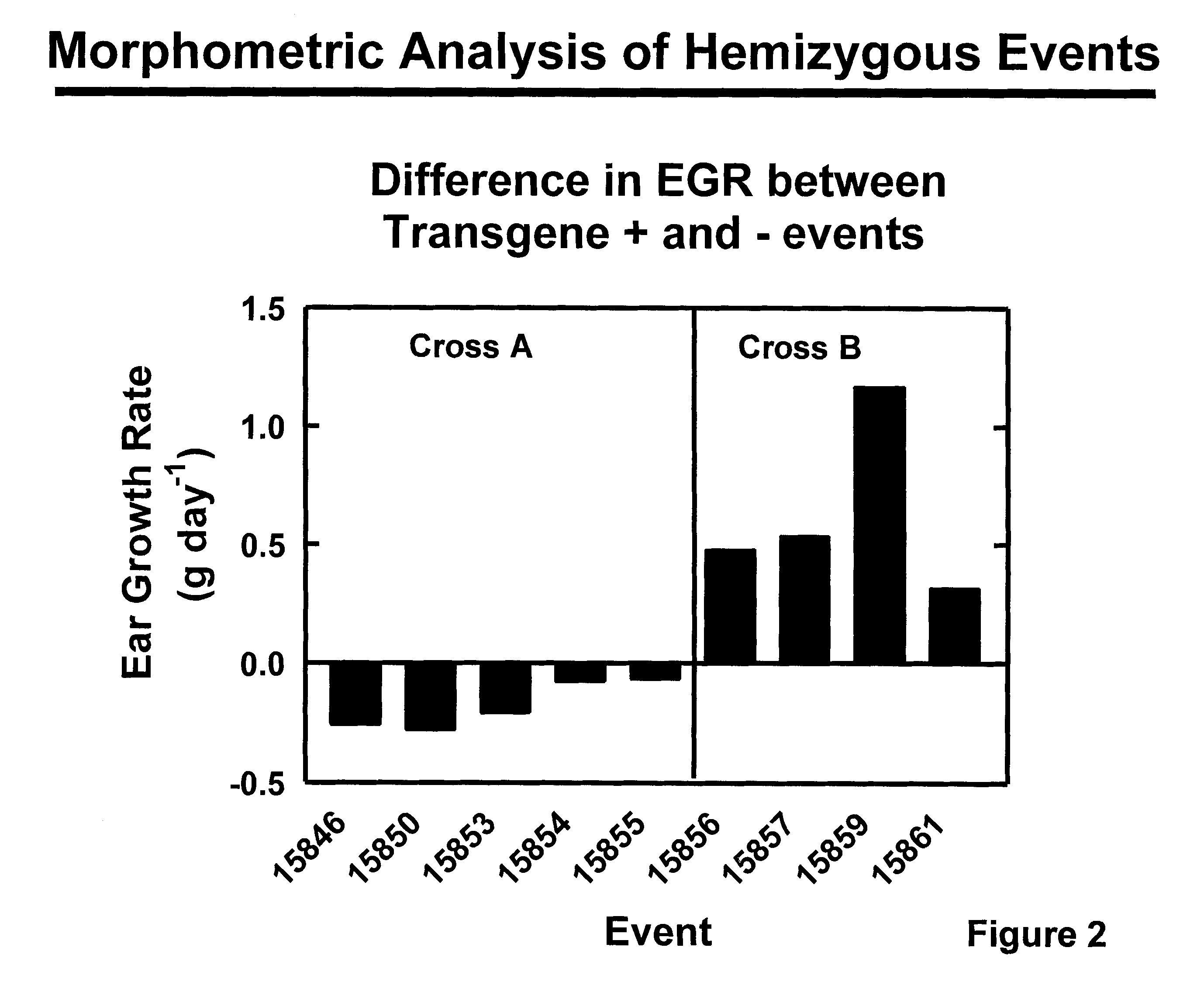Early Endosperm Promoter eep1
a promoter and endosperm technology, applied in the field of early endosperm promoter eep1, to achieve the effects of enhanced cytokinin activity, enhanced cytokinin activity, and enhanced cytokinin activity
- Summary
- Abstract
- Description
- Claims
- Application Information
AI Technical Summary
Benefits of technology
Problems solved by technology
Method used
Image
Examples
example 1
Construction of Vectors System for Temporal and Spatial Seed Preferred Expression of Cytokinin Biosynthetic Enzymes
Construction of PHP 11466 and PHP 11467 and Their Cointegrates (PHP11551 and PHP11552. Respectively).
[0280] PPH 11466 and PHP 11467 were employed in particle gun transformation protocols even though they have the right and left border for the tDNA. The versions designated PHP11551 and PHP11552 were used in Agro-mediated transformation protocols.
[0281] The ipt coding sequence was obtained as a 732 bp BamHI / HpaI fragment and inserted into a GLB1 expression cassette (BamHI / HpaI, 4.9 kb) to give PHP11310. The maize GLB1 promoter (Genbank Accession #L22344 L22295) and terminator (Genbank Accession #L22345 L22295) in PHP3303 comprise the GLB1 expression cassette. The pGLB1:ipt:GLB1 3′ cassette was moved as two pieces (HindIII / BamHI 1401 bp and BamHI / EcoRI 1618 bp) into a T-DNA vector digested with EcoRI+HindIII (6.33 kb) to give PHP11363. Finally, a selectable marker gene...
example 2
Transformation of Maize
Biolistics:
[0289] The inventive polynucleotides contained within a vector are transformed into embryogenic maize callus by particle bombardment, generally as described by Tomes, D. et al., (1995) Plant Cell, Tissue and Organ Culture: Fundamental Methods, Eds. O. L. Gamborg and G. C. Phillips, Chapter 8, pgs. 197-213 and is briefly outlined below. Transgenic maize plants are produced by bombardment of embryogenically responsive immature embryos with tungsten particles associated with DNA plasmids. The plasmids consist of a selectable and an unselected structural gene.
Preparation of Particles:
[0290] Fifteen mg of tungsten particles (General Electric), 0.5 to 1.8μ, preferably 1 to 1.8μ, and most preferably 1μ, are added to 2 ml of concentrated nitric acid. This suspension was sonicated at 0° C. for 20 minutes (Branson Sonifier Model 450, 40% output, constant duty cycle). Tungsten particles are pelleted by centrifugation at 10000 rpm (Biofuge) for one minute...
example 3
Identification of High Cytokinin Transgenic Corn Lines
[0303] The resulting transformants are screened for elevated levels of cytokinin using a combination of direct measurements and in vivo correlates.
Vivipary Experiments (glb1:ipt Constructs):
[0304] Because it is appreciated that seed dormancy is controlled by the ratio of ABA:cytokinin, an elevated cytokinin level in the seed could induce a viviparous phenotype.
[0305] Glb1::ipt transformants were initiated using GS3 embryos and either Agrobacterium-(inventive polynucleotides 11551 and 11552) or biolistic-(inventive polynucleotides 11466 and 11467) mediated transformation. Plantlets were regenerated 2-3 months later and these plantlets (T0's) were transferred to the greenhouse after an additional 2-3 months. At anthesis, T0's were crossed with HG11 and vivipary was detected in the developing T1 seed approximately 30 days later. Developing T1 seed that exhibited the viviparous phenotype was rescued by replanting without seed dr...
PUM
| Property | Measurement | Unit |
|---|---|---|
| temperature | aaaaa | aaaaa |
| temperature | aaaaa | aaaaa |
| pH | aaaaa | aaaaa |
Abstract
Description
Claims
Application Information
 Login to View More
Login to View More - R&D
- Intellectual Property
- Life Sciences
- Materials
- Tech Scout
- Unparalleled Data Quality
- Higher Quality Content
- 60% Fewer Hallucinations
Browse by: Latest US Patents, China's latest patents, Technical Efficacy Thesaurus, Application Domain, Technology Topic, Popular Technical Reports.
© 2025 PatSnap. All rights reserved.Legal|Privacy policy|Modern Slavery Act Transparency Statement|Sitemap|About US| Contact US: help@patsnap.com



